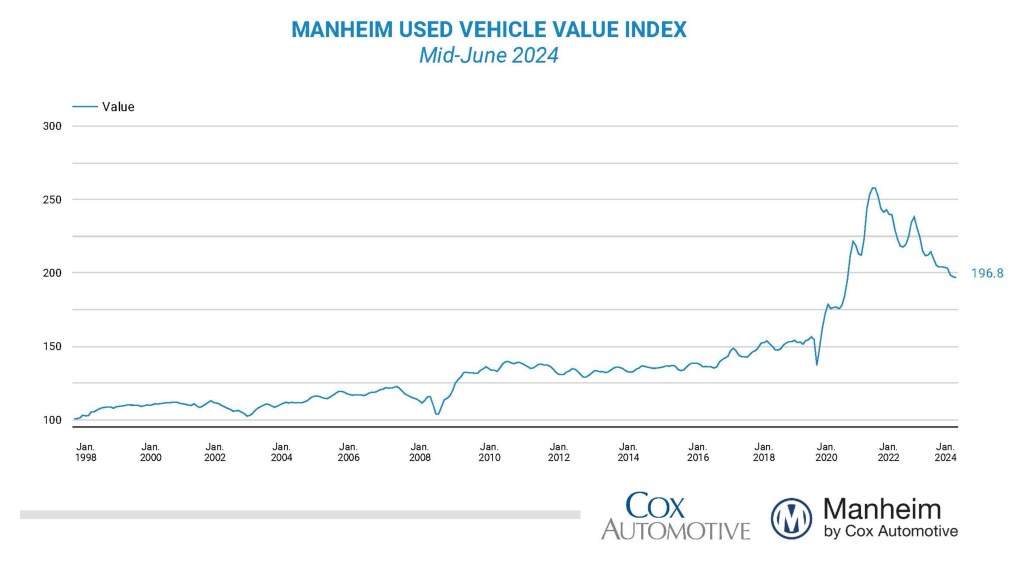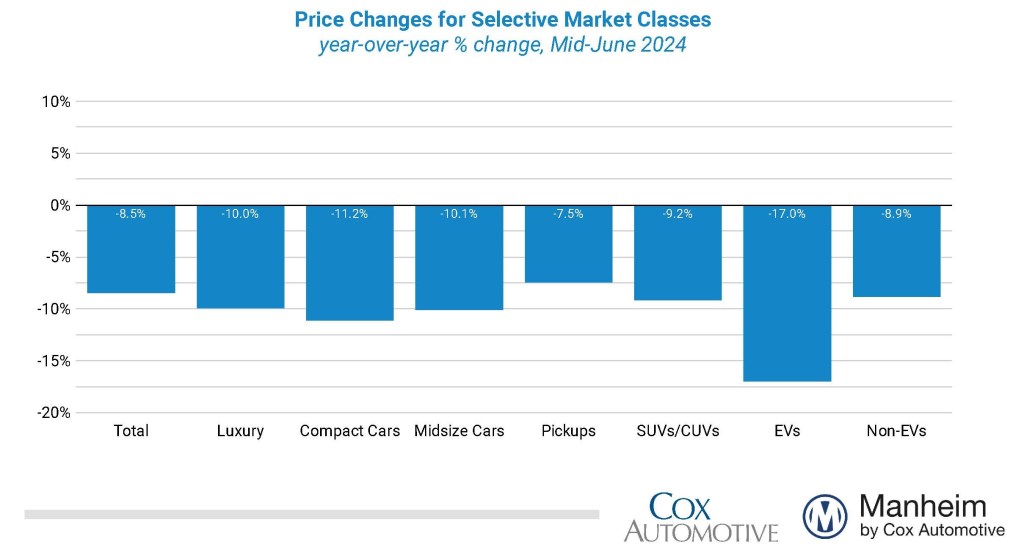Data Point
Wholesale Used-Vehicle Prices Decrease in First Half of June
Tuesday June 18, 2024
Wholesale used-vehicle prices (on a mix-, mileage-, and seasonally adjusted basis) decreased 0.3% from May in the first 15 days of June. The mid-month Manheim Used Vehicle Value Index fell to 196.8, which was down 8.5% from the full month of June 2023. The seasonal adjustment lessened the impact for the month. The non-adjusted price change in the first half of June declined 1.6% compared to May, while the unadjusted price was down 9.5% year over year.

“May ended with stronger than normal price declines in the last few weeks, and that’s continued into early June,” said Jeremy Robb, senior director of Economic and Insights at Cox Automotive. “We are still seeing higher sales conversion levels with days’ supply down as sales have continued to run above last year’s levels.”
Over the last two weeks, the Manheim Market Report (MMR) prices in the Three-Year-Old Index decreased an aggregate of 0.9%, which was above the typical normal decline of 0.2% observed at this time of year. Over the first 15 days of June, MMR Retention, the average difference in price relative to current MMR, averaged 98.7%, indicating that valuation models are lagging behind market prices early in June. MMR retention is down one-tenth of a point compared to the prior year at the beginning of June. The average daily sales conversion rate of 57.8% in the first half of the month was below the June 2019 daily average of 60.7%. The conversion rate has risen almost 2 points from May 2024, indicating that we are seeing stronger buying demand at wholesale markets since the end of May.
All major market segments saw seasonally adjusted prices that remained lower year over year in the first half of June. Compared to the industry’s year-over-year decline of 8.5%, the pickup segment was the only group to outperform the index overall, falling by 7.5% against 2023. The remaining segments did worse year over year, with SUVs down 9.2%, luxury falling by 10.0%, midsize cars declining 10.1%, and compacts performing the worst at down 11.2% year over year. However, several major segments demonstrated smaller price declines compared to May against the index performance. The overall industry fell 0.3% against the prior month; but SUVs increased by 0.5%, compact cars rose by 0.4%, and midsize cars rose by 0.2% over the same period. Falling more than the average, pickups were down 0.5%, and luxury declined by 1.0% against May 2024. Electric vehicles (EVs) were down 17.0% against values for June 2023, while the non-EV segment decreased by 8.9% over the same period. Compared to May, non-EVs increased 0.4% in the first half of June, while EVs were down 7.1% over the same period.

Wholesale supply is flat in mid-June. Leveraging Manheim sales and inventory data, we estimate that wholesale supply ended May at 26 days, up one day from the end of April and also against May 2023. Wholesale supply is relatively normal for this time of year, running within a day of longer-term levels for this week. As of June 15, wholesale supply was unchanged from the end of May at 26 days and year-over-year levels. However, wholesale supply remains down one day compared to 2019.
Rental Risk Prices Declined in the First Two Weeks of June
The average price for rental risk units sold at auction in the first 15 days of June was down 15.2% year over year. Rental risk prices also declined by 5.7% compared to the full month of May. Average mileage for rental risk units in the first half of June (at 49,900 miles) was down 12% compared to a year ago and fell by 11.6% against May 2024.
Consumer Sentiment Is Down in June
The initial June reading on Consumer Sentiment from the University of Michigan fell 5.1% to 65.6, the lowest level since June 2023. Views of current conditions declined more substantially than future expectations. Expectations for inflation in five years increased. Consumers’ views of buying conditions for vehicles fell to the lowest level since November 2022. Consumers’ views of vehicle prices declined, but the view of interest rates was slightly less negative. The daily index of consumer sentiment from Morning Consult continues to move around and fell last week. Sentiment declined 2.1% in May and was down 0.4% over the last week, though it is up 0.7% so far in June as of the 15th. Sentiment is down 0.6% year to date. The average unleaded gas price, according to AAA, increased 0.1% over the last week to $3.45 per gallon as of June 15, which was down 2% year over year and up 10.8% year to date. In June, gasoline prices are down 3.1%.
The next complete suite of monthly MUVVI data will be released on July 9, 2024, one day later than usually scheduled due to the July 4 holiday. The next quarterly call will be held on Tuesday, July 9, 2023, at 11 a.m. EDT. Register to attend.
For questions or to request data, please email manheim.data@coxautoinc.com. If you want updates about the Manheim Used Vehicle Value Index, as well as direct invitations to the quarterly call sent to you, please sign up for our Cox Automotive newsletter and select Manheim Used Vehicle Value Index quarterly calls.
Note: The Manheim Used Vehicle Value Index was adjusted to improve accuracy and consistency across the data set as of the January 2023 data release. The starting point for the MUVVI was adjusted from January 1995 to January 1997. The index was then recalculated with January 1997 = 100, whereas prior reports had 1995 as the baseline of 100. All monthly and yearly percent changes since January 2015 are identical. Learn more about the decision to rebase the index.
